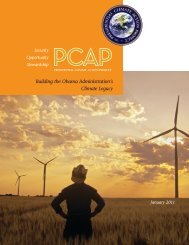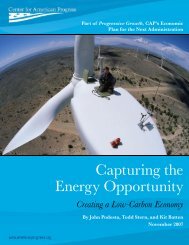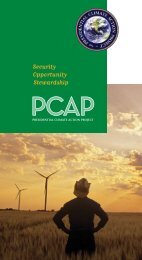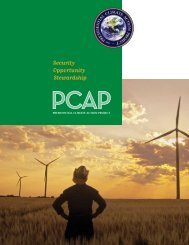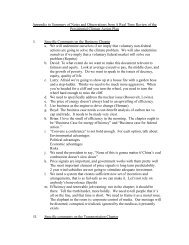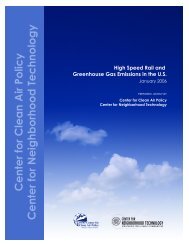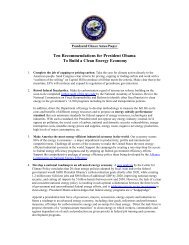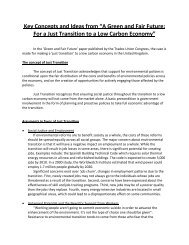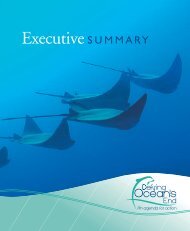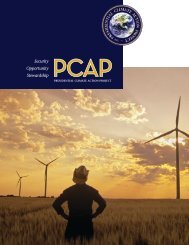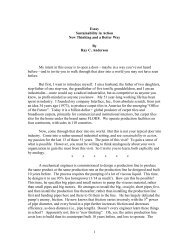PCAP - Presidential Climate Action Project
PCAP - Presidential Climate Action Project
PCAP - Presidential Climate Action Project
- No tags were found...
Create successful ePaper yourself
Turn your PDF publications into a flip-book with our unique Google optimized e-Paper software.
The President’s authority over the federal executive budget is broad. The procedure required isfound in the Congressional Budget and Impoundment Control Act of 1974 (the Budget Act). 295Pursuant to the Budget Act, “The President shall prepare budgets of the United StatesGovernment . . . .” 31 U.S.C. §1104(a). See Proposal C-1.Further, management policies that address climate change, energy efficiency, energyconservation and the like are supported by, further the purposes of, or reaffirm and strengthennational policy and programs established by legislation. For example, an entire subchapter of theEnergy and Independence Security Act of 2007 (EISA) is devoted to energy savings ingovernment and public institutions. 296 The EISA is “an act to move the United States towardgreater energy independence and security, to increase the production of clean renewable fuels, toprotect consumers, to increase the efficiency of products, buildings, and vehicles, to promoteresearch on and deploy greenhouse gas capture and storage options, and to improve the energyperformance of the Federal Government, and for other purposes.” 297 See also Proposal C-3 for amore comprehensive list of statutes that make pollution prevention, energy conservation and thelike a national goal or priority. Further, it appears unavoidable that GHGs will be regulatedunder the CAA (see Proposal B-7). The measures contemplated here would be consistent withthat effort.Presidents have issued broad sweeping executive orders in regard to management practices thataddress pollution prevention, environmental sustainability, energy efficiency, energyconservation, and GHG reduction policies and programs. In this regard, the following are somekey orders: 298 (1) E.O. 11912 Delegation of Authorities Relating to Energy Policy andConservation, April 13, 1976; (2) E.O. 12003, Relating to Energy Policy and Conservation, July20, 1977; (3) E.O. 12759, Federal Energy Management, April 17, 1991; (4) E.O. 12902, EnergyEfficiency and Water Conservation at Federal Facilities, March 8, 1994; (5) E.O. 13101,Greening the Government through Waste Prevention, Recycling, and Federal Acquisition,September 14, 1998; (6) E.O. 13123, Greening the Government through Efficient EnergyManagement, June 8, 1999; (7) E.O. 13148, Greening the Government through Leadership inEnvironmental Management, April 21, 2000; and (8) E.O. 13423, Strengthening FederalEnvironmental, Energy, and Transportation Management, January 24, 2007. E.O. 13123 and13423 explicitly address GHG emissions, and E.O. 13123 states, “[t]he Federal Government, asthe Nation’s largest energy consumer, shall significantly improve its energy management inorder to save taxpayer dollars and reduce emissions that contribute to air pollution and globalclimate change.”In addition there are numerous executive orders issued to address specific aspects of federalmanagement, or a more limited subject matter, for example: 299 (1) E.O. 11602, Providing forAdministration of the Clean Air Act with Respect to Federal Contracts, Grants, or Loans, June29, 1971; (2) E.O. 11738, Providing for Administration of the Clean Air Act and the FederalWater Pollution Control Act with Respect to Federal Contracts, Grants, or Loans, September 10,295 See 31 U.S.C. §§ 1103 et. seq. (formerly the Budget and Accounting Procedures Act of 1950).296 42 U.S.C. Chapter 152, Subchapter 4, § 17001 et. seq.297 Pub. L. No. 110-140, 110 Stat. 1659 (Dec. 19, 2007).298 Many of these are no longer in effect.299 Many of these are no longer in effect.CEES 74 | P age



